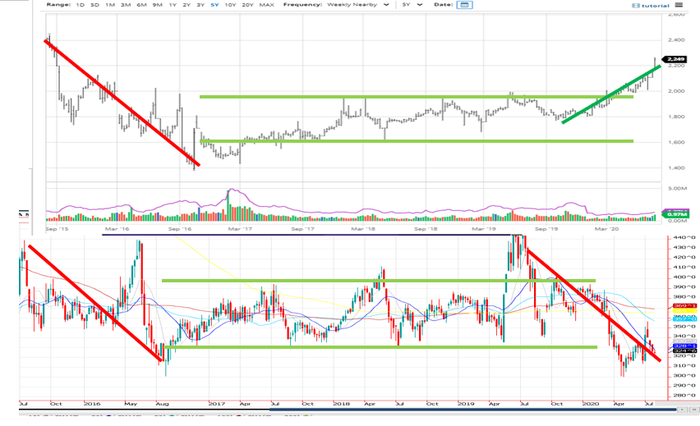
In January U.S. and Chinese negotiators concluded the phase one trade deal. For a long time we did not see any purchases and there was much skepticism whether or not China would meet their agreements.
The naysayers of the U.S.-China agreement continue to tout how far behind they are in dollars spent. Year-to-date they have bought $6 billion worth of goods versus $4.8 billion a year ago and $7.5 billion in 2017 (benchmark year).
Based on this data China is clearly behind the commitment for this year and it is unlikely that they will meet their financial target .
However, the agreement was a two-year target and COVID-19 Is likely to cause U.S. negotiators to offer some flexibility.
As for agricultural goods, China has been stepping up to the plate and swinging the bat as hard as they can. Just this week China made the third largest U.S. corn purchase on record by purchasing 1.937 million metric tons with an additional 130,000 tons to ‘unknown’ for a total of 2.067 million metric tons in one day.
That’s about 82 million bushels of corn.
Two weeks prior, AgMarket.Net analyst Jim McCormick reported the 5th largest sale in the record book at 1.762 million metric tons (about 70 million bushels). To the best we can track, China has bought 7.8 million metric tons of corn year to date. This compares with USDA's projection of 7 million metric tons to be bought from all sources for the entire year (July WASDE). This week we also saw China sell another 4 million metric tons from their reserves at $7.39 per bushel. The country’s corn market, as you can see from the top graph below, is at the highest price since 2015 compared to the U.S. market depicted by the lower graph which is at the lowest prices.
Obviously there is a large import spread that is very favorable towards Chinese importers.

Furthermore, we believe that this week China increased their TRQ (tariff rate import) quotas from 7.2 million metric tons to 9.2 million metric tons. It is very possible that an additional 5 million metric tons could be added to this total.
Chinese soybean purchases have been incredible, with this week’s export sales report showing China bought 1.989 million metric tons of beans and unknown categories 1.233 for a total of 3 million metric tons in one week.
U.S. agriculture has not seen these types of purchases for years.
Underestimated demand?
Tracking these sales to determine if USDA has underestimated demand is difficult since USDA does not break down source origin relative to their total estimated Chinese purchases. For instance, in USDA's recent world supply demand tables, it estimated china corn imports would be 7 million and 96 million metric tons of soybeans. But USDA does not tell us how much of that total the U.S. is to ship.
Thus, when we estimate if USDA will need to revise exports, you need to realize we are assuming a percentage of market share for these numbers.
Based on our calculations, it appears USDA may be able to revise Chinese corn demand up by 198 million bushels or approximately 2.4 bushels per acre and soybean demand up 98 mil bu. or a little over one bushel per acre. On the demand side alone, it is definitely supportive and friendly.
However, when we look at crop conditions at 73 to 74% good to excellent compared to 54 and 58% a year ago, it is difficult for traders to think a yield revision will not outpace a demand revision. As a result, rallies have failed to follow through.
We believe that the market is fairly balanced at current price levels and downside exposure is only about 20 cents given the potential yield increase and demand increase. We also believe the 7% decline in the U.S. dollar lends support to all commodities that are exported.
Weak dollar impact
History tells us that a weak dollar does not necessarily mean a bull market is in order, but it does mean that yesterday's price is outdated and that our commodities just got 7% cheaper in the world. If they need it…. our commodities are a blue light special right now.
Our advice right now is make sure you have enough sales made to meet your cash flow requirements in to 2021. We are also selling options for certain clients. These positions can add up to $0.30 on top of corn sales and $0.80 on top of soybean sales. There is no downside risk but there is a commitment to agree to a ceiling price of $3.60 in Dec20 corn and $9.60 in Nov21 beans.
We also believe producers should consider storing as many bushels as possible and utilizing the government loan program for cash flow. The reason for maintaining ownership is twofold: First, we don't want to be selling too much corn at a low price when the producer is vulnerable to reduced insurance payments if markets rally and you don’t have ownership to offset. Second, contacts within our organization suggest Chinese purchases could far exceed USDA's projections. No one knows if China is simply meeting phase one requirements or if it will be importing its production/consumption deficit (which is 15 to 20 mmt corn) and/or rebuilding emergency reserves.
Remember when…
In July of 1972, Russia started to buy U.S. wheat and corn under an agreement. Russia was in a Cold War with the United States and political tensions were very high, yet we made a trade deal.
The original deal had the Soviets buying around $750 million worth of grain during a three-year span. But they spent $750 million in only one month and continued buying. When Russia started to buy, the market ignored the potential impact of new demand and cited huge U.S. supplies of corn that we needed to get rid of anyway.
At about the same time the U.S. dollar started to weaken, and inflation started to take over. The fiscal policy along with new demand helped the market find its feet and start to move higher into 1973.
By 1974 grain traders realized that this demand was real and at the same time producers were facing adverse weather.
When it was all said and done, nearby corn futures moved from the July 1972 price of $1.20/bu. and tripled the price to $4/bu. by October 1974.
That was the first U.S. Great Grain Robbery. Is it possible that we are seeing the second? We sure need to get rid of it anyway.
About the Author(s)
You May Also Like






